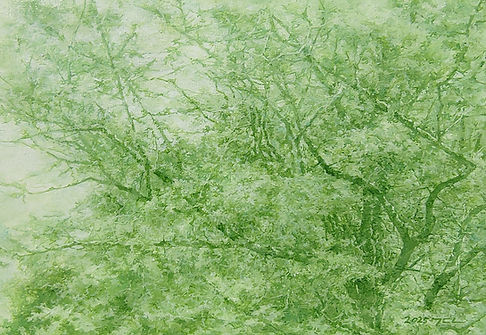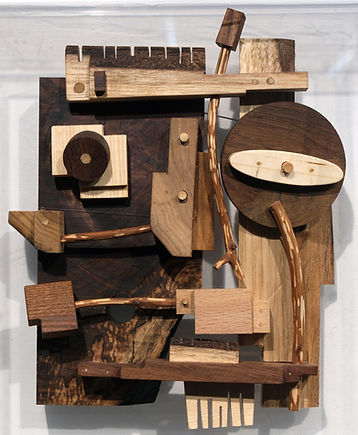The Vibrations of Sky, the Earth, and the Body:
Seonggook Hong, Sora Shin, DongNim Kim, Gwang Mi Kim, SangHo Won, HyoJin Choi, Hyung Jin Park
By Elga Wimmer


Gwangmi Kim, Blow, 2021, mixed media on canvas, 72.7x72.7 cm
Hyungjin Park, Drawing lines in space, 2025, Acrylic on Canvas, thread, 162 x 130cm
In this group show at Paris Koh Fine Arts, Vibrations from the Earth, the Sky and the Body, seven Korean artists interpret intangible energies from the macrocosm and the microcosm — the connection between the physical and spiritual world — in various media of painting, sculpture and works on paper. The show, which marks the first collaboration between
Paris Koh Fine Arts, in the U.S., and PHJ Gallery, in Korea, will be on view from June 1 through June 14, 2025.
The most important element in Vibrations from the Earth, the Sky and the Body is the combining of Asian practice and beliefs with those prevalent in the West.
GwangMi Kim in a series titled Blow juxtaposes monochromatic blocks of colors in blue, black and red with calligraphic brush strokes. The work reflects East meets West, a message from one to the other via artistic language, a sign of communication between two worlds. Minimal painting started as a movement in the West in the 1960’s – with simple monochromatic shapes in rectangles and squares - Calligraphy, the art of showing signs in an expressive, harmonious, and skillful manner, dates all the way back to the Shang dynasty (1600 – 1046 BCE). Very different visually, the link between these two art movements lies in their order, simplicity, harmony, and meditation.


DongNim Kim, That Place I & II, 90.9 x 65.1 cm, Acrylic on canvas, 2025
In her landscape paintings, DongNim Kim studies light and color, expresses emotions and tells stories. Her work is inspired by the Han River estuary, a border region where the artist currently lives. Kim draws from the rhythm of life and calls her simple technique
“just a steady honest commitment to the act of painting.” Kim shares an affinity with landscape painting with some of the greatest landscape painters as i.e. Claude Monet and Caspar David Friedrich. Her work resonates with the Hudson River School insofar as she is dedicated to plein-air painting.
HyungJin Park’s work is playing with the element of chance, using threads randomly thrown across a painted area of his canvas. The accidental form emerging is the result the artist thrives for – bypassing intentionality to access a purer form of expression and to combine chance with intent. Dada and Surrealist artists used chance operations like dropping torn paper onto a surface and then fixing them in place to create collages. These artists of the past believed – like HyungJin Park - that chance could reveal the laws of nature and liberate art from the constraints of reason. French artist Jean Arp in particular experimented with gravity and the elements of chance by dropping a piece of cord taking a random shape he used as an outline of his drawings. In Park’s case threads and acrylic paint form an abstract shape resembling a Chinese language character, a Zen Garden stone or a cloud formation.
Sora Shin uses optical illusion in her paintings, a contemporary version of the pioneers of the Op Art movement in the 1980’s as Bridget Riley and Victor Vasarely. By weaving lenticular sheets, the artist achieves a moving wavelike aspect, changing slightly according to the position of the viewer. Wave: Balanced Blue and Wave: Mature Red are masterful renditions of moving pixels, as Op-art fabric or falling dominoes. Sora Shin is interested in the space in between, the uneasy gap – what allows the world to breathe. Chance plays a crucial role, even though the imagery seems to be meticulously planned. The same aspect plays a part in Zen Buddhism: the acceptance of the spiritual and the unplanned moment,
essential in the creative process.


Sora Shin, Wave - Mature Red, 2024, Weaving Lenticular Sheets, 105x105cm
Seong Gook Hong, Gaze-Human, Nature, Society, 2025, Ink, glue on cotton on panel, 100×100 Cm
In SeongGook Hong series of paintings, Gaze – Humanity, Nature, Society, we see a black square with concentric circles from various shades of black to dark grey, like ripples around a stone thrown into water. Visually this recalls the black holes – mysterious places in space where nothing, not even light, can escape. The central motif which can be interpreted as a target, recalls Jasper John’s use of the target as a visual metaphor. It represents both a literal object and a symbol, a gaze into nothingness, inviting the viewer to meditate. Like Johns, Hong challenges the viewer to look behind the surface. The target’s concentric circles evoke both a sense of order and hypnotic pull, leading the viewer to question not only what they are seeing; but how they are seeing it.
SangHo Won composes multi-colored squares with mixed media (crystal resin, acrylic and oil on wood) that appear as playful collages of puzzles, faces, maps and patterns. Even though the artist sees these squares symbolically as limiting, and as confined structures determining our lives (some of them are titled Conflict), his work exudes the joyfulness of child-play reminiscent of Outsider Art. Won looks outside the box so to speak, outside the frame, for distraction from daily chores and rules, often utilizing repetitive patterns and techniques to establish a sense of order and expressiveness in an otherwise chaotic world.


Sangho Won, Square PLAY-Mountain Keeper, 26x30 cm, Wood, Oil, 2024
HyoJin Choi, Go-gun (고건) 8: Break frame of all thoughts and ideals, 2024, Oil on Canvas 100 x 72.5cm
HyoJin Choi’s art-making process is slow and meditative, deeply rooted in Asian ways of seeing and philosophy, the very essence of the old Masters of calligraphy. Choi uses layer upon layer of oil paint – taking up to a year for each painting – to work on her series titled Go-gun. Go means think, Gun to soar – a thought that takes flight as a bird’s wings. Poetic and grounded simultaneously, Choi’s paintings have a depth similar to Anselm Kiefer’s layers of earth, branches, and yarn. The emotional and philosophical states of mind are expressed by the artist as her records of being.
Fritz Lang’s 1927 film classic, Metropolis, envisioned a future society ruled by robots, machines. These seven artists propose a return to spirituality, in today’s technological age, where an adolescent’s best friend often turns out to be an AI character.

대지와 하늘, 그리고 몸으로부터의 진동:
홍성국, 신소라, 김동님, 김광미, 원상호, 최효진, 박형진
글: 엘가 윔머
파리코 화인아트(Paris Koh Fine Arts)에서 열리는 이번 단체전 대지와 하늘, 그리고 몸으로부터의 진동에서는 일곱 명의 한국 작가들이 회화, 조각, 종이 작업 등 다양한 매체를 통해 거시적 세계와 미시적 세계, 즉 물질적 세계와 정신적 세계 사이의 보이지 않는 에너지와 진동을 해석합니다. 이 전시는 미국의 파리코 화인아트와 한국의 PHJ 갤러리 간의 첫 협업을 기념하는 자리로, 2025년 6월 1일부터 6월 14일까지 전시됩니다.
이 전시에서 가장 주목할 점은 동양의 사유와 예술적 실천이 서양의 예술 전통과 어떻게 만나고 조우하는지를 보여준다는 데 있습니다.
김광미 (GwangMi Kim)은 Blow 연작에서 파란색, 검정, 빨강의 단색 블록과 서예적 붓질을 병치합니다. 이 작업은 동양과 서양의 조우, 곧 예술적 언어를 통한 세계 간의 소통을 암시합니다. 서양의 미니멀 회화는 1960년대 단색의 사각형 구성을 특징으로 등장했으며, 반면 서예는 기원전 1600–1046년 상나라까지 거슬러 올라가는 동양의 정신적이고 형식적인 예술입니다. 시각적으로 매우 다른 두 표현 방식이지만, 그 본질에는 질서, 단순함, 조화, 명상의 가치가 공통으로 자리합니다.
김동님 (DongNim Kim)의 풍경화는 빛과 색을 연구하며 감정을 표현하고 이야기를 전달합니다. 현재 그녀가 거주하고 있는 접경지대인 한강 하구의 자연에서 영감을 받은 그녀는 삶의 리듬에서 그림을 끌어내며 자신의 기법을 “그저 꾸준하고 정직한 그림에의 헌신”이라고 표현합니다. 그녀의 작업은 클로드 모네나 카스파 다비드 프리드리히 같은 위대한 풍경화가들과도 교감을 이루며, 특히 자연에 대한 직접적인 관찰과 실외 제작을 중시하는 허드슨 강 화파의 정신을 계승하고 있습니다.
박형진(HyungJin Park)은 우연성을 작업의 핵심 요소로 삼습니다. 작가는 실을 캔버스에 무작위로 던지고 그로 인해 생성된 우연한 형태를 작품의 핵심으로 삼습니다. 이는 의도를 넘어선 순수한 표현을 지향하는 태도이며, 다다이즘과 초현실주의가 우연을 창작의 수단으로 사용했던 방식을 떠올리게 합니다. 장 아르프(Jean Arp)가 중력을 활용해 줄을 떨어뜨리고 그 궤적을 회화의 형태로 삼았던 실험처럼, 박의 작품에서는 실과 아크릴 물감이 마치 한자의 획, 선禪의 정원 속 돌, 혹은 구름의 형상처럼 추상적인 조형을 이룹니다.
신소라(Sora Shin)는 렌티큘러 시트를 활용해 시각적 착시를 일으키는 회화를 제작합니다. 그녀의 작업은 1980년대 오프 아트(Op Art)의 선구자 브리짓 라일리(Bridget Riley)나 빅터 바자렐리(Victor Vasarely)의 시도에 현대적 해석을 더한 것입니다. Wave: Balanced Blue와 Wave: Mature Red와 같은 작품들은 움직이는 픽셀, 직조된 패브릭, 혹은 도미노처럼 시선을 따라 변화를 일으키며 움직입니다. 신소라는 ‘사이의 공간’, 즉 불안정한 틈을 주목합니다. 그 틈이야말로 세상이 숨 쉬는 공간입니다. 이미지가 철저히 계획된 듯 보이지만, 실제로는 우연성이 창작에 중요한 역할을 하며, 이는 불확정성과 직관을 중시하는 선불교의 사유와도 맞닿아 있습니다.
홍성국(SeongGook Hong)의 응시 – 인간, 자연, 사회 연작은 짙은 검은 사각형 속에 농담의 차이를 두고 그린 동심원이 마치 돌을 던졌을 때 수면에 생기는 파문처럼 펼쳐집니다. 이 형태는 빛조차 탈출할 수 없는 우주의 블랙홀을 연상시키며, 시각적으로는 재스퍼 존스(Jasper Johns)의 ‘표적’과도 유사합니다. 표적은 하나의 상징이자 실체이며, 동시에 무(無)를 응시하게 하는 명상의 도구입니다. 홍의 작업은 단순히 시각적 이미지를 넘어 관객으로 하여금 ‘무엇을 보는가’뿐 아니라 ‘어떻게 보는가’를 자문하게 합니다.
원상호(SangHo Won)는 크리스털 레진, 아크릴, 유화 물감 등을 나무 패널에 혼합해 다채로운 색상의 정사각형 콜라주를 구성합니다. 지도, 얼굴, 퍼즐 조각처럼 보이는 이 작업들은 일상의 틀과 구조를 상징하는 동시에, 작가 스스로 ‘제약’으로 여기는 사각형 안에서 유희와 자유를 추구합니다. 일부 작품 제목인 Conflict처럼 제약 속에서도 아웃사이더 아트를 연상시키는 유쾌함과 반복적인 패턴을 통해 질서와 표현을 동시에 담아냅니다. 원은 일상의 규칙에서 벗어나 프레임 너머의 세계를 탐색하고자 합니다.
최효진(HyoJin Choi)은 느리고 명상적인 회화 과정을 통해 동양적 사유의 본질을 구현합니다. 고건(고: 생각할 고, 건: 날아오를 건) 연작은 ‘생각이 날개를 달고 비상하는 상태’를 은유하며, 한 점당 1년 가까운 시간을 들여 수십 겹의 유화 층을 쌓아 완성합니다. 그녀의 작품은 안젤름 키퍼(Anselm Kiefer)의 대지적 재료성과 중첩된 층위를 떠올리게 하며, 내면의 감정과 철학적 사유를 고요하고 깊이 있게 기록합니다.
1927년 프리츠 랑(Fritz Lang)의 영화 메트로폴리스는 기계가 지배하는 미래 사회를 상상했습니다. 이와는 대조적으로, 이 전시의 일곱 작가는 기술의 시대, 청소년의 가장 친한 친구가 AI일 수 있는 오늘날에, 다시금 영성과 감각, 그리고 인간 고유의 존재성을 되찾아야 함을 제안합니다.

Elga Wimmer
Elga Wimmer is an esteemed art critic and curator known for her insightful writing and curatorial work that bridges contemporary art with philosophical, cultural, and historical contexts. With a career spanning decades in New York and beyond, she has contributed to the visibility of international artists, particularly those exploring conceptual, feminist, and cross-cultural themes. Her critical voice is marked by intellectual depth and a keen sensitivity to the spiritual and political undercurrents in contemporary artistic practices.
Chief Editor: Paris Koh
